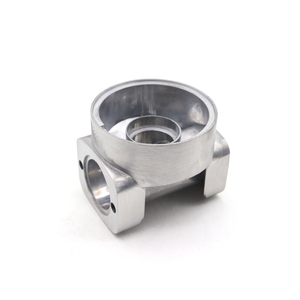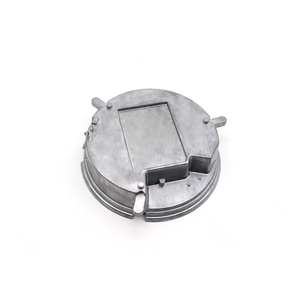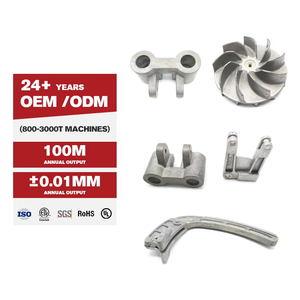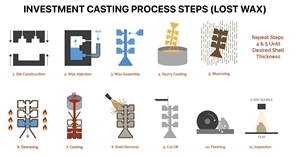
All categories
Featured selections
Trade Assurance
Buyer Central
Help Center
Get the app
Become a supplier

(535 products available)




















































The aluminum die-cast rear wheel hub is a mechanical component that connects the rear wheel to the axle, allowing for smooth wheel rotation and vehicle control. It is found on popular rear-wheel vehicles like trucks and electric bikes. The rear-wheel hub is crucial for vehicle performance and safety. A small problem with the hub can lead to dangerous situations, like wheel locking, hub failure, or even accidents. Regular inspection and maintenance are necessary to ensure optimal performance and safety. Once the problem is detected, the rear-wheel hub needs to be replaced. However, not all aluminum die-cast rear-wheel hubs are the same. They come in different types, which are:
Single wheel hub:
The single aluminum die-cast rear wheel hub is the most common type found in most vehicles. As the name suggests, this hub supports one wheel on either side of the vehicle. It is designed for lightweight and low-friction applications, making it suitable for everyday cars and light trucks.
Dual wheel hubs:
The dual aluminum die-cast rear wheel hub is commonly seen in heavy-duty trucks and commercial vehicles. Each rear axle has one dual hub, which supports two wheels on each side of the vehicle. This design offers better weight distribution and increased load capacity, making it suitable for transporting heavy loads.
Wheel hub assembly:
The aluminum die-cast wheel hub assembly combines the hub, bearing, and ABS (anti-lock brake system) sensor ring into one unit. This assembly is pre-loaded and sealed for precision and cleanliness. The aluminum die-cast wheel hub assembly is commonly used in modern passenger cars. It helps improve safety, vehicle control, and stability.
Flange wheel hubs:
The aluminum die-cast flange wheel hub connects the hub to the axle using bolts. This design allows for easy hub replacement without changing the entire axle. Flange wheel hubs are commonly used in trucks, commercial vehicles, and some off-road vehicles.
Stud wheel hubs:
The aluminum die-cast stud wheel hub connects the hub to the axle using wheel studs that are threaded onto the hub. This design allows for direct attachment of wheels using lug nuts. Stud wheel hubs are the most common type of rear wheel hubs found in passenger cars, light trucks, and motorcycles.
Material
The heart of the rear wheel hub is the aluminum. Hubs made from other metals may be used on other vehicles. Aluminum die cast rear wheel hubs are preferred for the strength and lightweight of aluminum. The lightweight of the aluminum die cast rear wheel hub is an advantage. The lightweight helps the drive shaft turn quickly. The quick turning of the drive shaft helps the car to speed up quickly. The quick turning of the drive shaft to turn quickly reduces the load on the engine. The aluminum die cast rear wheel hub is also preferred because of the corrosion resistance of aluminum. The aluminum die cast rear wheel hub will not rust or corrode when the car is driven in wet weather or when the roads are salted in winter.
Size
The size of the rear wheel hub is important. The size of the rear wheel hub is determined by the size of the rear wheel. The size of the rear wheel hub is also determined by the size of the drive shaft. The rear wheel hub has to fit the rear wheel. The rear wheel hub also has to fit the drive shaft. A larger rear wheel hub will increase the size of the rear wheel. A larger rear wheel hub will also increase the size of the drive shaft. The larger rear wheel hub will increase the weight of the rear wheel. The larger rear wheel hub will also increase the load on the rear wheel. The larger rear wheel hub will decrease the speed of the car. The size of the aluminum die cast rear wheel hub is given in millimeters.
Number of bolts
The number of bolts on the aluminum die-cast rear wheel hub is important. The number of bolts is determined by the number of holes in the rear wheel. The number of bolts on the rear wheel hub has to match the number of holes in the rear wheel. A typical aluminum die cast rear wheel hub has 5 to 8 bolts.
Maintenance of the aluminum die cast rear wheel hub
It is important to maintain the aluminum die cast rear wheel hubs properly. The maintenance of the aluminum die cast rear wheel hub helps to increase the life of the rear wheel hub. The maintenance of the aluminum die cast rear wheel hub involves checking the rear wheel hub for wear. The rear wheel hub is also checked for damage. If the aluminum die cast rear wheel hub is worn, the rear wheel hub is replaced. The rear wheel hub is also replaced if the rear wheel hub is damaged. The bolts of the aluminum die cast rear wheel hub are checked regularly. The bolts of the rear wheel hub are tightened. Lubricant is applied to the bolts of the rear wheel hub. The aluminum die cast rear wheel hub is cleaned regularly. Dirt and mud are removed from the rear wheel hub. The aluminum die cast rear wheel hub is protected from corrosion.
Choosing the right aluminum die-cast rear wheel hub is essential for meeting customer needs and maintaining a competitive edge in the market. Here are some key factors to consider when selecting these products:
Understand the Target Market:
It is important to sell the rear wheel hubs that are suitable for the target audience. For example, car hubs used for sports cars should be lightweight and have high strength. On the contrary, hubs for heavy trucks need to be more durable and load-bearing. Different types of vehicles require different sizes and designs of hubs. Therefore, understanding customers' needs can help determine the type of aluminum die-cast rear wheel hub to sell.
Quality and Performance:
Buyers should conduct quality inspections on suppliers and know the performance of rear wheel hubs. A high-quality hub can ensure smooth operation of the wheels and prolong its service life. Meanwhile, superior hubs reduce the frequency of wheel hub bearing replacement, saving users' time and maintenance costs.
Specifications and Compatibility:
Buyers need to ensure that the rear wheel hubs they purchase are compatible with their customers' vehicles. This includes checking parameters such as vehicle model, wheel size, and bolt pitch circle diameter. It is also necessary to select customized aluminum die-cast rear wheel hubs according to customers' special requirements.
Brand Reputation:
Buyers can select aluminum die-cast rear wheel hub manufacturers with high brand reputation and established a good market image. Well-known brands usually provide superior quality products and perfect after-sales service. Additionally, buyers can read reviews from other customers to understand the quality and performance of aluminum die-cast rear wheel hubs.
Price:
Buying agents need to find a balance between quality and cost. They should compare the pricing of different suppliers while considering the quality and performance of the products. Additionally, buyers can negotiate with suppliers for discounts or other favorable terms to obtain better profits.
After-sales Service and Warranty:
Buyers should pay attention to the warranty and after-sales service of the aluminum die-cast rear wheel hub provided by the supplier. A good warranty can reduce the buyers' risks and after-sales service can help solve problems in time.
The aluminum die-cast hub is one of the crucial parts of a motorcycle. Any damage to the wheel hub will affect the overall performance of the motorcycle. So, it is necessary to check the wheel hub regularly and replace it if necessary. Replacing a rear wheel hub is a straightforward process. With the right tools, this can be done quickly. Below is a step-by-step guide on how to replace a rear wheel hub:
1. Before starting the process, make sure that the new rear wheel hub is available and matches the motorcycle's specifications.
2. Get the necessary tools, including a jack, wheel chock, wrench set, torque wrench, socket set, hub puller, and rubber mallet.
3. Park the motorcycle on a flat surface and engage the wheel chock.
4. Loosen the lug nuts using the wrench and lift the motorcycle with a jack.
5. Remove the wheel: Take off the lug nuts and remove the wheel from the motorcycle.
6. Remove the brake rotor and caliper: Detach the brake rotor from the wheel hub and the brake caliper from the mounting bracket.
7. Disconnect the hub from the suspension components and the drive system.
8. Use a hub puller or rubber mallet to detach the wheel hub from the rear axle.
9. Install the new wheel hub by placing it on the rear axle and ensuring it fits snugly.
10. Reconnect the drive system and suspension components to ensure that everything works perfectly.
11. Reattach the brake rotor and caliper, followed by the motorcycle wheel. Tighten the lug nuts properly, and lower the motorcycle.
12. Check the alignment and adjust it if necessary. Spin the wheel to see if it clears the brake components and the swingarm.
13. Before taking the motorcycle on the road, ensure everything is properly installed and tightened. Recheck the torque specifications for critical fasteners.
Q1: What is a rear wheel hub?
A1: The rear wheel hub is a part that connects the wheels to the car. It is important for being able to drive the car and for the wheels spinning properly. Without a strong and working hub, the car will not drive correctly.
Q2: What is a rear wheel hub bearing?
A2: The rear wheel hub bearing is a set of small metal pieces inside the hub that allows the wheels to turn smoothly with less friction. It supports the wheel's weight and helps it spin without problems.
Q3: Why is the rear wheel hub bearing important?
A3: The rear wheel hub bearing is important because it lets the wheels turn easily. If it breaks, the wheels will not spin the right way, causing problems. A good hub bearing is key for the wheels to work properly and keep the car driving smoothly.
Q4: How to tell if a rear wheel hub bearing is bad?
A4: Signs of a bad hub bearing include strange noises like grinding or roaring sounds when driving, especially turning, feeling vibrations in the car, having wobbly tires, or warning lights on the dashboard. Hub problems can also cause uneven tire wear or affect braking and handling. It's best to get it checked if any of these symptoms are noticed.
Q5: Can I drive with a faulty rear wheel hub bearing?
A5: It's not safe to drive with a faulty hub bearing. It can lead to tire problems, affecting how the car drives and potentially causing a flat tire. Serious hub issues can also affect braking and handling, risking being in an accident. It's best to fix any bearing problems before they get worse.